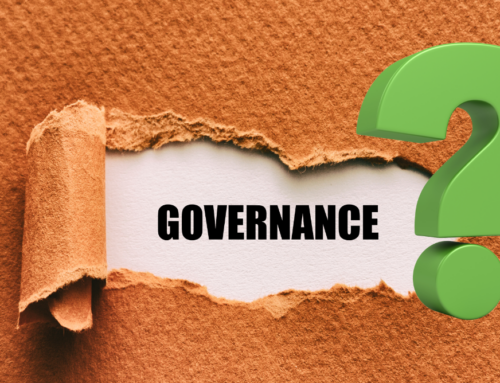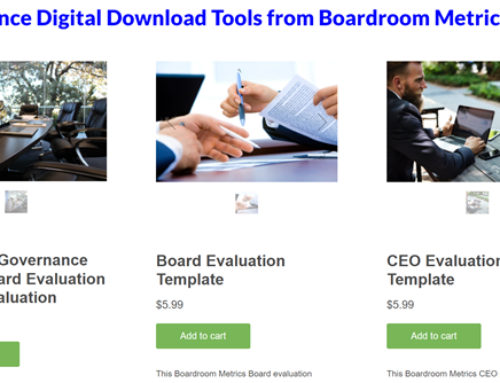Avoiding Corporate Governance Failures Begins With Better Understanding the Board’s Oversight Role
Boardroom Metrics has been involved in corporate governance consulting now for over twenty years. We’ve also served as Directors for public, private and not-for-profits organizations. Here’s what we’ve learned about avoiding corporate governance failures:
- The #1 reason for corporate governance failures is that Boards and Directors remain unclear on their role. Many Boards spend too much time on operating activities. Others spend too much time on low impact governance concerns. As a result, insufficient effort goes into the actual oversight that is fundamental to corporate governance (governance = oversight).
- There are only three areas of Board governance oversight. They are: identification and mitigation of risk; approval and oversight of strategic direction; and performance management of the CEO (the person responsible for executing strategic direction). Refocusing the Board’s oversight activities (Board meetings, management reporting, Committee work) around these three areas helps ensure that governance failures don’t occur because the Board is focused on the wrong priorities.
- Most Boards need to increase the attention they pay to market (external) and operating (internal) risk. Almost all Boards overvalue their focus on financial risks. In many cases, financial risks occurs after something else has gone wrong; after something has changed in the market or the operation. Boards need to become just as demanding on marketing and operations reporting as they are on financial reporting.
- Boards should evaluate corporate strategy on the basis of how well risks are being mitigated and how well the organization’s mission is being achieved. Those are the only two reasons for having corporate strategy. However, we regularly find that Boards aren’t clear on risks or the mission of the organization they are governing. Many Boards aren’t aware of the links between risk, strategy and corporate governance.
- CEO’s should be evaluated on the basis of how well they are executing the Board’s approved strategy. Many CEO’s we work with aren’t evaluated at all. Also, there are many Directors who see themselves ‘working for the CEO’. That is not the Board’s role. CEOs’ are employees. Performance management is just as good for CEO’s as it is for any other employee in the organization.
In summary, the key to avoiding corporate governance failure is to clarify the Board’s oversight responsibilities and laser-focus its efforts on risk, strategy and CEO performance management.
Board Oversight Infographic
This infographic captures the focused Board role and execution that helps organizations avoid corporate governance failure.
There are only three elements of corporate governance: 1) identify risk 2) validate and approve strategies for mitigating risk and executing mission, and 3) performance managing the CEO’s execution of the strategic plan.
What makes this definition effective is the onus it puts on the Board to execute these elements – and only these elements – in their governance discussions.
Sound too simple? Try this. Out of the limited amount of time your Board has available to provide strong corporate governance, how much time is going towards the role outlined here?
- Risk comes in four flavours. Legal, financial, environmental (outside the organization) and operational (inside the organization). Most Boards are reasonably well informed on the legal and financial risks. Not so much on the environmental and operational risk. In the early days of the smart phone era, RIM’s Board managed to miss the risk posed by the iPhone. VW’s Board missed the risk posed by faked emissions results. What risks might your Board be missing?
- Strategy is what separates sustainable leaders from lifestyle organizations. Strategy starts with mission. Quick, what’s the mission of your organization? Boards cannot govern effectively unless they understand who the organization is serving and how it serves them. Once a Board understands that, everything else – the strategies, tactics, even the org chart – fall into place. (Note: in the governance audit work we do, most Boards and Directors CANNOT consistently articulate the mission of their organization, ie everyone has a different idea of what the mission is)
- Hiring and performance managing the CEO. Most Boards understand their role to hire the right CEO. An increasing number of Boards understand that performance management of the CEO is also part of their role. CEO’s are generally the only employee reporting to the Board. We expect every other employee to be well managed. The same must apply to the CEO.
The Five Elements that Make Board Operations Effective
For a Board to focus on risk, strategy and the role of the CEO it needs to have these five elements in place. Here’s how:
- Board Composition: The trend in corporate governance is to competency-based Boards – Boards comprised of Directors with the skills and expertise to understand risk, strategy and performance of the CEO. If this sounds like a no-brainer, it’s not. There are still many, many Boards where composition is driven by membership, geographic and community representation – not necessarily competencies reflecting the risks and strategies the organization is facing. What’s the composition of your like? Do you have someone who understands technology risk? Corporate strategy? Finance? Legal?
- Board Information: Information that informs the Board on risk, strategy and performance of the CEO. Think of the information your Board receives. How well does it help you understand the environmental and operational risks the organization is facing? What is the iPhone equivalent threat in your business? Is it Amazon? How much does you Board understand about Amazon? What additional information is required for you to be better informed?
- Board Processes: Processes like Board meeting agendas help keep the Board focused on risk, strategy and performance of the CEO. If you look at your last Board meeting agenda, how much time was dedicated to the three elements of the Board’s role? If each of the agenda items had been reframed in the context of risk, strategy or CEO performance what would have disappeared from the agenda? What different questions would you have asked?
- Board Leadership: It’s the Board leaders (Chairs and Committee Chairs) who ultimately determine what the Board focuses on. Some take their direction from the CEO – a basic governance mistake. Others are respected, experienced leaders who understand the Board’s role and the relationship with the CEO. As a Board Chair, what kind of focus are you leading your Board towards?
- Board Culture: Studies show that organizations with Boards who work well together and with the CEO perform better. However, working well together doesn’t mean always agreeing on everything. Focus your Board and CEO on risk and strategy. How well is it working together on these priorities? What’s missing?
About Boardroom Metrics
Boardroom Metrics was founded over twenty years ago. We focus on Boards and Corporate Governance effectiveness. Our specialties:
- External Board Evaluations. We use customized surveys, interviews and other assessment tools to evaluate how effectively public, private and not-for-profit Boards of Directors understand and execute their Board role.
- External CEO Evaluations. We use customized surveys, interviews and other assessment tools to evaluate the CEO’s performance versus the Board’s expectations, business objectives and personal development goals. CEO Evaluation templates are available for download here.
- Board, CEO and Leadership Team Succession Planning. We provide tools and consulting to help Boards develop criteria and processes for planned and unplanned succession.
- Governance Speaking, Consulting and Coaching. We speak to/work with Boards, Associations, and other groups on Corporate Governance, the Board’s role, and the processes and tools for executing Corporate Governance effectively.
Download These Governance eBooks
Board Governance for Private Business – 16 Answers for Owners
Medical Group Board Governance – A Short Guide for Healthcare Directors
Boardroom Metrics Contact information:
- Email: [email protected]
- Phone: 416-994-6552
- Website: https://www.boardroommetrics.com/
- LinkedIn: linkedin.com/company/boardroom-metrics









Leave A Comment